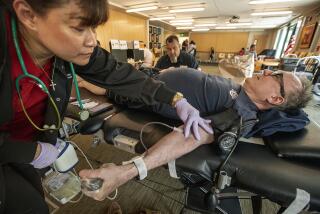Patients Do Well Without Transfusions During Surgery
- Share via
TRENTON, N.J. — Bloodless surgery, gaining popularity because of religious caveats against blood transfusions and general fears of contracting infections, is getting another boost from research showing that patients who refuse transfusions generally fare well.
That’s the conclusion of a National Institutes of Health study by Dr. Jeffrey L. Carson and colleagues at the University of Medicine and Dentistry of New Jersey.
“In recent years, there’s been a push to limit blood use,” partly because of lingering fears about contracting AIDS and other blood-borne diseases, said Carson, professor and chief of the division of general internal medicine at the university’s Robert Wood Johnson Medical School in New Brunswick.
Jehovah’s Witnesses, who oppose transfusions because of biblical precepts about the sacredness of blood, have pushed doctors and hospitals for better medical care without the procedure.
That pressure spurred doctors at Englewood Hospital two years ago to create the New Jersey Institute for the Advancement of Bloodless Medicine and Surgery. It has handled some 1,500 medical and surgical cases, 90% of them Jehovah’s Witnesses.
In a study published recently in the British medical journal Lancet, Carson and colleagues examined the case records of 1,958 adult Jehovah’s Witnesses who underwent surgery without transfusions from 1981-94 at 12 U.S. hospitals, including Robert Wood Johnson University Hospital in New Brunswick and Cooper Hospital-University Medical Center in Camden.
“When you look at the overall mortality rates, it says that most patients do well and that withholding blood may be a safe way of treating them,” Carson said.
His study found that only about 3% of the Jehovah’s Witness patients died within a month of surgery, but the risk of death was 4.3 times higher in those with heart disease than those without. The death rate was about 25 times higher for patients with a hemoglobin count half of normal than for those near normal. Hemoglobin is the molecule in red blood cells that carries oxygen to the body’s tissues.
Carson is seeking another grant from the National Heart, Lung and Blood Institute for a study of thousands of patients comparing outcomes of those receiving transfusions early in treatment to those not receiving them until their hemoglobin count hits half of normal.
That should teach doctors more about when they can avoid the immune-system effects and other risks of transfusions, which are much more likely than HIV transmission. It also may help hold down costs slightly, given the estimated $1 billion to $2 billion spent on U.S. blood transfusions annually.
“We think it’s an area worth pursuing because even though the blood supply is safe, if you reduce transfusions, you reduce risk,” said Dr. George J. Nemo, group leader in the national blood institute’s transfusion medicine scientific research group.
Nemo noted the need to resolve recent controversy among physicians over how low to let hemoglobin levels fall before transfusions.
The attention could spur expansion of some of the 53 bloodless-surgery programs at U.S. hospitals recognized by the Jehovah’s Witnesses.
At Englewood Hospital, which treats patients referred from 15 states, a team of surgeons, plus nurses, anesthesiologists and other staff coordinates each patient’s medical or surgical treatment according to his or her wishes, through nurse manager Sherri Ozawa, who is herself a Jehovah’s Witness.
The New Jersey Institute, one of the region’s most comprehensive bloodless-medicine programs, has yet to lose a patient and has even treated some only days old, according to co-director Dr. Aryeh Shander.
One success story is machinist Clayton Lawson of Delhi, N.Y., who was diagnosed with a brain tumor in January, when his wife was two months pregnant.
“It was very deep in the brain,” he said. “I didn’t know what I was going to do.”
After surgeons at two New York state hospitals refused to do the risky, bloody operation without a transfusion, the 36-year-old Jehovah’s Witness turned to the Englewood program.
He recovered so quickly, Lawson said, that he left the hospital after three days and was back to work in two months. With the pulsating tumor gone, so were the constant headaches and frequent dizziness, nausea and memory problems that had been worsening.
Among the techniques Englewood doctors use to reduce blood loss are cryosurgery, or superfreezing tissue to be removed; cutting tissue with a vibrating laser called a harmonic scalpel that minimizes bleeding; suctioning blood from incisions and returning it to the patient’s body, and hemodilution.
In hemodilution, blood rich in the hemoglobin-carrying red blood cells is pumped from a vein and held in an attached device until surgery ends while intravenous fluids are pumped into the veins to increase the blood volume and pressure.
The doctors often use hormones and other methods to boost a patient’s critical hemoglobin level before surgery. The program also treats many nonsurgical patients with blood disorders, such as sickle cell anemia, Shander notes.
“You can get people through complex surgery, as well as medical problems, without transfusion,” he says.






